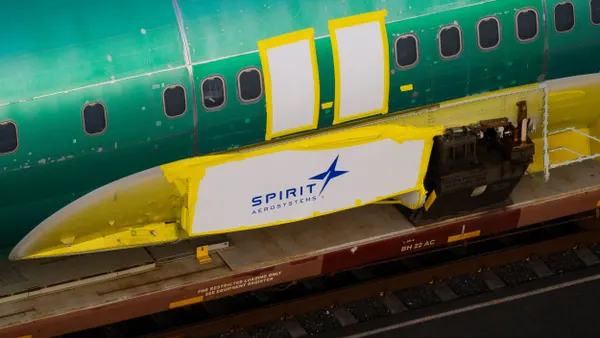Dive Brief:
- Boeing’s commercial aircraft deliveries in the third quarter continued to improve, rising about 38% to 160 aircraft, up from 116 planes for the same period last year.
- The aircraft giant delivered 121 of its 737 model aircraft, six 767s, nine of its 777s and 24 of its 787 units in Q3.
- Boeing’s commercial gross orders also hiked up to 821, nearly outpacing 2023’s orders of 848 for the same period.
Dive Insight:
Various media reports have stated that the plane manufacturer is on track to deliver the most planes since 2018, when the company delivered 568 aircraft by the end of Q3 that year.
Still, Boeing is trailing its competitor, Airbus, which has delivered 507 and aims to ship 820 by the end of 2025.
Boeing’s deliveries rise about 38% YoY in Q3 2025
While Boeing has not disclosed its commercial delivery goals, research and analysis aerospace firm Forecast International anticipates the company will deliver around 590.
FI believes the number is feasible for Boeing to achieve, as the company has been averaging 49 deliveries per month through Sept. 30, and as long as 737 production remains stabilized and continues to deliver the remaining 737 and 787 inventory. Still, Boeing will need to average 50 deliveries per month by year’s end.
Where Boeing has Airbus beat is in its orders backlog, with 821 compared to its competitor’s 514. Boeing has recently secured orders for its 737, 777 and 787 Dreamliner planes from Norwegian Group, Uzbekistan Airways, Turkish Airlines, Macquarie AirFinance, Cathay Pacific and Gulf Air.
Last month, Canada-based airline WestJet announced that it had made its largest aircraft order ever, committing to purchasing at least 67 more Boeing planes scheduled for delivery through 2034.
Boeing’s orders hiked up about 161% and deliveries rose about 51% YoY
The Trump administration has been helpful regarding the increased commercial plane orders, President and CEO Kelly Ortberg said at Morgan Stanley’s 13th Annual Laguna Conference in September.
“The balance of trade activity and the tariff activity has certainly put a keen focus on airlines and on our aircraft,” Ortberg said. “There’s no better way to correct the balance of trade than to buy a large number of aircraft. And certainly, we’re the beneficiary of that.”
Ortberg noted that aircraft pricing is “almost independent” of the current trade demand activity, as Boeing has “inflationary pressure coming from the supply chain.”
The company is also seeing an increase in demand for commercial airlines to expand passenger capacity, as some of its customers have upgraded to larger aircraft to address the need, providing Boeing with “some opportunity for higher pricing.”
Boeing has production goals, having reached its 38 planes per month cap back in May, a number set by the Federal Aviation Administration as part of its increased oversight after the Alaska Airlines incident. However, the agency is slowly easing its control over the company’s production. The FAA announced last month it was allowing Boeing limited authorization to issue airworthiness certificates for some of its 737 Max and 787 Dreamliner models.
The company aims to progressively increase production to 42 planes per month by the end of 2025, provided Boeing stabilizes its manufacturing process, Ortberg said. Still, the company head added that he felt “really good” about where the company stands for the next rate increase, as Boeing has more rate increases in its plan, provided the plane maker does not encounter any supply chain issues.
“I think where we’ll get to where that inventory is more balanced with the supply chain, probably around the 47 a month production rate,” the Boeing CEO said. “And we’ll see how well the supply chain aligns there, and that will determine how fast we can move beyond that rate.”
Boeing is one step closer to owning one of its suppliers. The company gained the European Commission’s approval on Monday to acquire fuselage supplier Spirit AeroSystems for $4.7 billion, though with some prerequisites. The EU was previously concerned that the pending transaction would reduce competition in the global aerostructure and commercial aircraft markets, particularly Airbus, according to the agency’s press release dated Oct. 13.
“This could have driven up prices and make large commercial aircraft parts harder to find, meaning that European passengers could face higher ticket costs,” Teresa Ribera, EVP for the European Commission for a Clean, Just and Competitive Transition, said in a statement.
Boeing provided remedies to address the EU’s concerns by agreeing to sell Spirit AeroSystems’ segments that supply components to Airbus. The fuselage supplier initially announced in April that it reached an agreement with Airbus to compensate the company $439 million for taking ownership of some of its factory sites and production assets.
Boeing also committed to divesting Spirit AeroSystems’ site in Malaysia to Composites Technology Research Malaysia, which also supplies components to Airbus. Spirit AeroSystems announced in August that it reached a deal with CTRM, which agreed to pay the fuselage supplier $95.2 million for its assets in the country.















